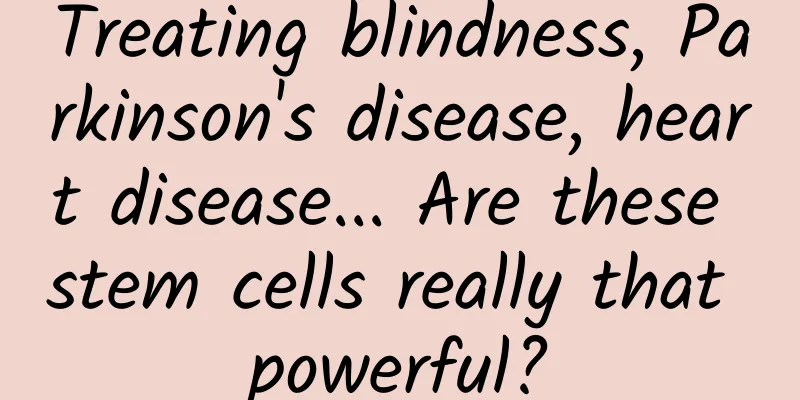Treating blindness, Parkinson's disease, heart disease... Are these stem cells really that powerful?

|
Author: Zhu Jieying (Guangzhou Institutes of Biomedicine and Health, Chinese Academy of Sciences) The article comes from the Science Academy official account (ID: kexuedayuan) —— In 2019, Kohji Nishida, an ophthalmologist at Osaka University in Japan, performed surgery on a woman in her forties and transplanted corneal stem cells into the woman's damaged cornea. So far, one month after the surgery, the patient's cornea is still clear and her vision has improved, and she can already read books and newspapers. Kohji Nishida, an ophthalmologist at Osaka University in Japan (Photo source: Kohji Nishida's personal website) The meritorious device this time was induced pluripotent stem cells (iPSCs). How did it restore the patient's sight? What other uses does this type of stem cell have at present? Corneal transplant → Corneal stem cell transplant The cornea is a transparent structure in front of the eye that covers the iris and pupil. Under normal circumstances, there are corneal stem cells that can be renewed and repaired when necessary to keep the cornea transparent so that light can penetrate. If these corneal stem cells are damaged and cannot maintain the cornea, it will lead to impaired vision or even blindness. Before the emergence of this new technology from Nishida, patients with damaged corneas could only passively wait for corneal transplants, which would be a long and painful process. On average, only 1 in 70 patients could get a new cornea. Stem cell technology has brought bright hope to some of them. Cornea (Image source: Nature News) Based on the success of the animal experiment, the Japanese Ministry of Health approved Nishida and others to perform four corneal repair surgeries. It should be noted that Nishida and others transplanted corneal stem cells instead of corneas, and this technology is only suitable for patients with corneal stem cell deficiency. The woman who recently underwent surgery suffered from limbal stem cell deficiency (LSCD), a hereditary disease in which the stem cells in the cornea continue to decrease, the cornea becomes dry and white, resulting in blurred vision and eventually blindness. The researchers cultured iPS cells into a thin layer of corneal stem cells and transplanted them into the patient's cornea. These corneal stem cells must have the ability to self-renew, both to maintain a quiescent stem cell state and to produce differentiated offspring to maintain the balance of the organ (cornea). Whether this clinical trial can achieve long-term success also depends on whether there is a normal functional niche in the limbal stroma of LSCD patients. According to Nishida, they will perform the second operation later this year and make more people available for the operation within the next five years. If it can be put into clinical application, this method will eventually alleviate the shortage of corneal transplants to a certain extent. iPS cells are working hard to treat Parkinson's disease, spinal cord injury, heart disease, etc. Induced pluripotent stem cell technology refers to the technology of inducing somatic cells to become pluripotent stem cells through reprogramming. It was first discovered by Shinya Yamanaka of Kyoto University in Japan in 2006. iPS cells are similar to embryonic stem cells in morphology, gene and protein expression, epigenetic modification status, cell multiplication ability, embryoid body and teratoma generation ability, differentiation ability, etc. Shinya Yamanaka also shared the Nobel Prize in Medicine and Physiology with Sir John B. Gurdon of the United Kingdom in 2012. The process of induction of iPS cells Shinya Yamanaka, a stem cell scientist at Kyoto University in Japan (Photo source: https://hot-fashion.click/wp-content/uploads/2015/10/山中申弥.jpg) iPS technology does not use embryos or eggs, so there are no ethical issues. The preparation of specific stem cells from the patient's own body cells can greatly reduce the possibility of immune rejection. The emergence of iPS technology has caused a strong response in the fields of stem cells, epigenetics, and biomedicine, giving people a new understanding of the regulatory mechanism of pluripotency and further shortening the distance between stem cells and clinical disease treatment. iPS technology has great potential value in cell replacement therapy, pathogenesis research, new drug screening, and the treatment of clinical diseases such as neurological diseases and cardiovascular diseases. Japan has been at the forefront of the world in exploring the clinical application of iPS cells. The world's first clinical application was in Japan. In 2014, Masayo Takahashi, a stem cell researcher at the Center for Developmental Biology at the RIKEN Institute of Physical and Chemical Research, transplanted iPS-derived retinal pigment epithelial cells into a woman in her 70s to treat age-related macular degeneration (an eye disease that causes blindness in the elderly). Masayo Takahashi, an ophthalmologist at the Center for Developmental Biology (cdb) in Kobe, Japan (Image source: Nature News) In 2018, the experimental team of Masahiko Takahashi's husband, stem cell scientist Takahashi Jun of Kyoto University in Japan, implanted neuronal progenitor cells transformed from iPS cells into the brains of Parkinson's patients for the first time. These cells can produce the neurotransmitter dopamine [3]. In February 2019, the Japanese Ministry of Health approved a study on the use of iPS cells to treat spinal cord injuries. Hideyuki Okano, a stem cell scientist at Keio University in Tokyo, will induce iPS cells to become neural progenitor cells and inject them into patients with spinal cord injuries. The research team will conduct experimental treatments on four people and decide whether to start larger-scale clinical trials based on the results [4]. Hideyuki Okano, a stem cell scientist at Keio University in Tokyo Chinese scientists have also taken action in this area. According to registration information from the U.S. Clinical Trials Database, China is conducting two iPS clinical trials: one is conducted by Nanjing Drum Tower Hospital affiliated to Nanjing University Medical School and the First Affiliated Hospital of Nanjing Medical University, which will use iPS-derived cardiomyocytes for intramyocardial transplantation during coronary artery bypass grafting in patients with chronic ischemic cardiomyopathy [5]; the other is conducted by Beijing University of Chinese Medicine and its affiliated Sun Simiao Hospital, which will use iPS-derived cardiomyocytes for transplantation to treat coronary heart disease, dilated cardiomyopathy and Keshan disease [6]. However, large-scale clinical application has to wait. Although there have been so many clinical trials, it is unrealistic to expect iPS cells to be widely used in clinical practice in the short term. It usually takes about 20 years to transfer a scientific discovery to clinical and commercial applications, and the application of iPS cells will roughly follow the same trajectory. Even more than a decade after the discovery of iPS cells, researchers still don't fully understand how reprogramming actually happens. iPS cells from patients and healthy controls behave very differently in culture due to differences in genetic background or gene expression. Like all cell lines, iPS cells vary between strains, which requires strict controls in experiments. The safety of iPS cell technology also needs to be controlled. For example, before Takahashi Masahiko and others were about to perform the second transplantation operation, Yamanaka Shinya's research team found two small genetic changes in the patient's iPS cells and iPS-derived retinal pigment epithelial cells. Although there was no evidence that these two mutations were related to tumor formation, they stopped the experiment at Yamanaka Shinya's suggestion [2]. For any iPS cell therapy, it will take years to find the right recipe to make the right cell type in sufficient quantities and purity. Researchers must be persistent and patient, and they will need strong support from the pharmaceutical industry and governments. In short, iPS cells are not magic. Like any new technology, it still takes a lot of time and follow-up research before it can enter clinical application and benefit mankind. So... now when you hear "stem cell treatment for xx disease", be careful! References: 1.Woman is first to receive cornea made from 'reprogrammed' stem cells 02 SEPTEMBER 2019 https://www.nature.com/articles/d41586-019-02597-2 2.Japanese woman is first recipient of next-generation stem cells 12 September 2014 https://www.nature.com/news/japanese-woman-is-first-recipient-of-next-generation-stem-cells-1.15915 3.'Reprogrammed' stem cells implanted into patient with Parkinson's disease 14 NOVEMBER 2018 https://www.nature.com/articles/d41586-018-07407-9 4.22 FEBRUARY 2019 'Reprogrammed' stem cells to treat spinal-cord injuries for the first time https://www.nature.com/articles/d41586-019-00656-2 5.https://www.clinicaltrials.gov/ct2/show/NCT03759405?term=ips+cells&cntry=CN&rank=2 6.https://www.clinicaltrials.gov/ct2/show/NCT03759405?term=ips+cells&cntry=CN&rank=2 Wu Lin, Ouyang Zhaohui, Cao Shuchao, Yi Delian, Sun Shaoxue & Liu Xia. (2005). Application and research progress of Raman spectroscopy. Journal of Light Scattering, 180-186. |
Recommend
7 months pregnant with lower abdominal pain
After 7 months of pregnancy, it is actually almos...
What to do if a girl has too much body hair
Nowadays, girls are very concerned about their im...
In spring, five types of common infectious diseases in children should be prevented in this way
In spring, everything comes back to life and the ...
Can pregnant women drink yogurt?
For pregnant women, they must know clearly what t...
Why can’t I get pregnant without taking any contraceptive measures? Consider four main factors
Many couples have always been eager to have child...
What will happen if you eat a box of blueberries every day? Will your skin really become whiter? Will your eyesight really improve?
In recent years, as a fruit with high nutritional...
Why more and more young people cannot live without "life-saving coffee" every day?
Audit expert: Yin Tielun Deputy Chief Physician, ...
Are lace or pure cotton pajamas better? What kind of fabric is more comfortable and easy to wear?
Pajamas are a common item in life, and they are l...
What happens when you press your belly during early pregnancy?
I believe everyone should know that women's b...
A couple was diagnosed with cancer because of "excessive frugality"? How many of these bad habits caused by "saving money" do you have?
Recently, a couple in Hangzhou, Zhejiang, were bo...
What foods should women eat for uterine prolapse
Uterine prolapse is a relatively common gynecolog...
How to safely prevent pregnancy
Safe contraception reduces the occurrence of acci...
What are the cultivation methods and precautions of Schefflera variegateda? Is Schefflera variegateda poisonous?
You have seen Schefflera arborvitae, but have you...
Will the fuel consumption be higher after the fuel consumption is reset to zero? What are the effects of resetting the fuel consumption to zero?
The fuel consumption of a new car is generally hi...
What is the expected date of delivery in March?
If you don't calculate the due date when you ...









